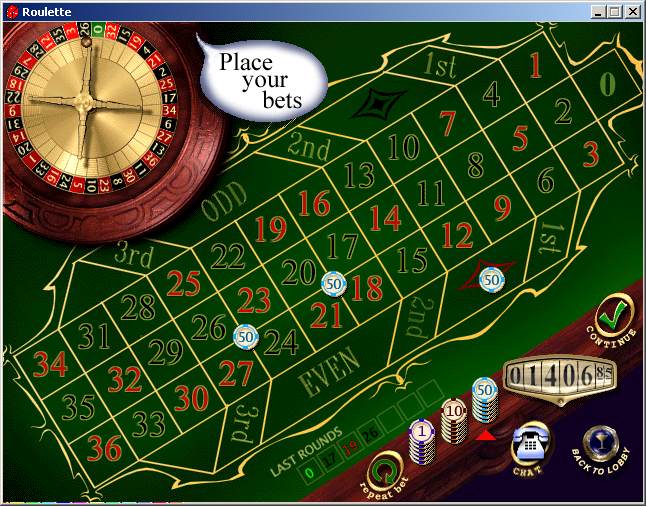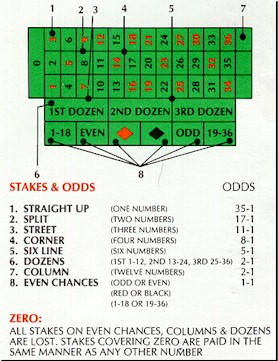-
1: How to play
The bets are made by using the mouse (drag and drop) and clicking on the "Continue" icon is as saying to the dealer to spin the wheel. In "Public" table you have to wait until all players put their bets. During the game you will see and hear the dealer (the computer) instructions : "Pleas put your bets" or "No more bets" it is tell you when the dealer is waiting to you or when you have to wait to next roll.

To place bets in Roulette, place your stack of chips on the roulette board. Depending on where you choose to place your chips, you can "cover" (bet on) anywhere from one to eighteen numbers with a single bet.
You can place nine different kinds of bets on the Roulette table. Each type of bet covers a certain range of numbers, and each type has its own payoff rate. The short lines of three numbers each are called rows on the board, while the longer lines, each holding twelve, are called columns. The first six types of bets are all made on the numbered space or on the lines between them and are called inside bets, while the last three types are made on the special boxes below and to the right of the board and are called outside bets.In table Roulette , when the ball stops its movement and comes to rest between any two Roulette metal partitions of the wheel, it marks the winning. Winning can be a number, a zero or double zero, winning color, and any other permitted symbol. The Roulette dealer immediately announces the winning number and its color, and he points with his index finger to the corresponding number on the layout. Some dealers place a plastic peg (a half inch diameter and two inches tall) on the winning number for all to see. He collects all losing bets, not disturbing the chips resting on winning spaces, and pays off the winner or winners with the correct amount of chips due to each winning bet. The signs 0 and 00 win for the bank all bets except those placed on 0 and 00.

Straight Up: Place your chips directly on any single number (including zero and double-zero.)
Split Bet: Place your chips on the line between any two numbers.
Street Bet: Place your chips at the end of any row of numbers. A street bet covers three numbers
Corner Bet: Place your chips at the corner where four numbers meet. All four numbers are covered.
Five Bet: This bet can be made in only one place and covers five number: zero, double zero, one, two and three.
Line Bet: Place your chips at the end of two rows at the intersection between them. A line bet covers all the numbers in either row, for a total of six.
Column Bet: Placing a chip in one of the boxes marked "2 to 1" at the end of the columns covers all the numbers in that column, a total of twelve. (Neither the zero nor the double zero are covered by any of the columns.)
Dozen Bet: Placing a chip in one of the three boxes marked "1st 12," "2nd 12," or "3rd 12" covers those twelve numbers.
Red/Black
Even/Odd
Low/High: A chip placed in one of the six boxes at the bottom of the board covers the half of the board described in that box. (The zero and double zero are not covered by any of these boxes.) Each box covers eighteen numbers.
-
2: Roulette Payouts
